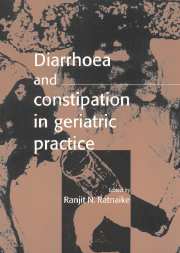Book contents
- Frontmatter
- Contents
- List of contributors
- Preface
- Acknowledgments
- Foreword by Gary R. Andrews
- I Defences of the aging gastrointestinal tract
- II Diarrhoea
- III Noninfectious clinical entities
- IV Constipation
- 16 Constipation: aetiology and diagnosis
- 17 Constipation: issues of management
- V Perspectives of altered bowel function
- Index
16 - Constipation: aetiology and diagnosis
Published online by Cambridge University Press: 17 August 2009
- Frontmatter
- Contents
- List of contributors
- Preface
- Acknowledgments
- Foreword by Gary R. Andrews
- I Defences of the aging gastrointestinal tract
- II Diarrhoea
- III Noninfectious clinical entities
- IV Constipation
- 16 Constipation: aetiology and diagnosis
- 17 Constipation: issues of management
- V Perspectives of altered bowel function
- Index
Summary
Constipation is a common complaint amongst older people, and a frequent concern for their health care providers in hospital, long-term care setting, clinics and general practice. Physician visits for constipation increase markedly for patients over 60 years old, and laxative use also increases with age. Around 30 per cent of older Australians use laxatives regularly, including 40 per cent of females over the age of 80. To understand this major health concern we need to examine the effects of age in the physiology of bowel function, the causes of constipation and diagnostic approaches.
Definition
Constipation can be defined as:
less than three bowel actions per week
reduced faecal volume
harder faecal consistency
straining on more than 25 per cent of occasions
excess faeces on rectal examination or abdominal x-ray
It is often more helpful to consider constipation as being possibly present when there is a change in one of these features in the individual. Older persons who have a regular bowel action each morning, passed with little straining, will appropriately consider themselves to be constipated if this suddenly changes to once every two days with straining every fourth occasion, even though this falls outside of the strict definition of constipation. Conversely, one needs to seek specific details of a self report of constipation before accepting this as the diagnosis.
- Type
- Chapter
- Information
- Diarrhoea and Constipation in Geriatric Practice , pp. 187 - 193Publisher: Cambridge University PressPrint publication year: 1999
- 2
- Cited by



